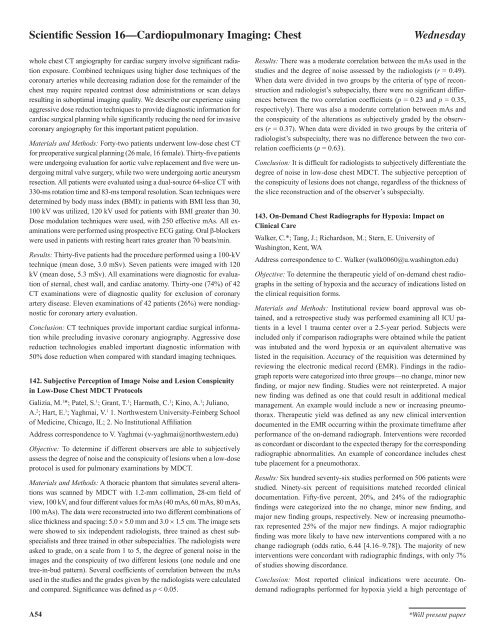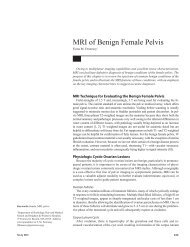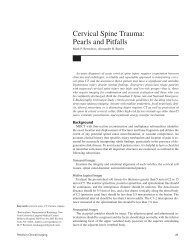Scientific Session 1 â Breast Imaging: Mammography
Scientific Session 1 â Breast Imaging: Mammography
Scientific Session 1 â Breast Imaging: Mammography
You also want an ePaper? Increase the reach of your titles
YUMPU automatically turns print PDFs into web optimized ePapers that Google loves.
<strong>Scientific</strong> <strong>Session</strong> 16—Cardiopulmonary <strong>Imaging</strong>: ChestWednesdaywhole chest CT angiography for cardiac surgery involve significant radiationexposure. Combined techniques using higher dose techniques of thecoronary arteries while decreasing radiation dose for the remainder of thechest may require repeated contrast dose administrations or scan delaysresulting in suboptimal imaging quality. We describe our experience usingaggressive dose reduction techniques to provide diagnostic information forcardiac surgical planning while significantly reducing the need for invasivecoronary angiography for this important patient population.Materials and Methods: Forty-two patients underwent low-dose chest CTfor preoperative surgical planning (26 male, 16 female). Thirty-five patientswere undergoing evaluation for aortic valve replacement and five were undergoingmitral valve surgery, while two were undergoing aortic aneurysmresection. All patients were evaluated using a dual-source 64-slice CT with330-ms rotation time and 83-ms temporal resolution. Scan techniques weredetermined by body mass index (BMI): in patients with BMI less than 30,100 kV was utilized, 120 kV used for patients with BMI greater than 30.Dose modulation techniques were used, with 250 effective mAs. All examinationswere performed using prospective ECG gating. Oral β-blockerswere used in patients with resting heart rates greater than 70 beats/min.Results: Thirty-five patients had the procedure performed using a 100-kVtechnique (mean dose, 3.0 mSv). Seven patients were imaged with 120kV (mean dose, 5.3 mSv). All examinations were diagnostic for evaluationof sternal, chest wall, and cardiac anatomy. Thirty-one (74%) of 42CT examinations were of diagnostic quality for exclusion of coronaryartery disease. Eleven examinations of 42 patients (26%) were nondiagnosticfor coronary artery evaluation.Conclusion: CT techniques provide important cardiac surgical informationwhile precluding invasive coronary angiography. Aggressive dosereduction technologies enabled important diagnostic information with50% dose reduction when compared with standard imaging techniques.142. Subjective Perception of Image Noise and Lesion Conspicuityin Low-Dose Chest MDCT ProtocolsGalizia, M. 1 *; Patel, S. 1 ; Grant, T. 1 ; Harmath, C. 1 ; Kino, A. 1 ; Juliano,A. 2 ; Hart, E. 1 ; Yaghmai, V. 1 1. Northwestern University-Feinberg Schoolof Medicine, Chicago, IL; 2. No Institutional AffiliationAddress correspondence to V. Yaghmai (v-yaghmai@northwestern.edu)Objective: To determine if different observers are able to subjectivelyassess the degree of noise and the conspicuity of lesions when a low-doseprotocol is used for pulmonary examinations by MDCT.Materials and Methods: A thoracic phantom that simulates several alterationswas scanned by MDCT with 1.2-mm collimation, 28-cm field ofview, 100 kV, and four different values for mAs (40 mAs, 60 mAs, 80 mAs,100 mAs). The data were reconstructed into two different combinations ofslice thickness and spacing: 5.0 × 5.0 mm and 3.0 × 1.5 cm. The image setswere showed to six independent radiologists, three trained as chest subspecialistsand three trained in other subspecialties. The radiologists wereasked to grade, on a scale from 1 to 5, the degree of general noise in theimages and the conspicuity of two different lesions (one nodule and onetree-in-bud pattern). Several coefficients of correlation between the mAsused in the studies and the grades given by the radiologists were calculatedand compared. Significance was defined as p < 0.05.Results: There was a moderate correlation between the mAs used in thestudies and the degree of noise assessed by the radiologists (r = 0.49).When data were divided in two groups by the criteria of type of reconstructionand radiologist’s subspecialty, there were no significant differencesbetween the two correlation coefficients (p = 0.23 and p = 0.35,respectively). There was also a moderate correlation between mAs andthe conspicuity of the alterations as subjectively graded by the observers(r = 0.37). When data were divided in two groups by the criteria ofradiologist’s subspecialty, there was no difference between the two correlationcoefficients (p = 0.63).Conclusion: It is difficult for radiologists to subjectively differentiate thedegree of noise in low-dose chest MDCT. The subjective perception ofthe conspicuity of lesions does not change, regardless of the thickness ofthe slice reconstruction and of the observer’s subspecialty.143. On-Demand Chest Radiographs for Hypoxia: Impact onClinical CareWalker, C.*; Tang, J.; Richardson, M.; Stern, E. University ofWashington, Kent, WAAddress correspondence to C. Walker (walk0060@u.washington.edu)Objective: To determine the therapeutic yield of on-demand chest radiographsin the setting of hypoxia and the accuracy of indications listed onthe clinical requisition forms.Materials and Methods: Institutional review board approval was obtained,and a retrospective study was performed examining all ICU patientsin a level 1 trauma center over a 2.5-year period. Subjects wereincluded only if comparison radiographs were obtained while the patientwas intubated and the word hypoxia or an equivalent alternative waslisted in the requisition. Accuracy of the requisition was determined byreviewing the electronic medical record (EMR). Findings in the radiographreports were categorized into three groups—no change, minor newfinding, or major new finding. Studies were not reinterpreted. A majornew finding was defined as one that could result in additional medicalmanagement. An example would include a new or increasing pneumothorax.Therapeutic yield was defined as any new clinical interventiondocumented in the EMR occurring within the proximate timeframe afterperformance of the on-demand radiograph. Interventions were recordedas concordant or discordant to the expected therapy for the correspondingradiographic abnormalities. An example of concordance includes chesttube placement for a pneumothorax.Results: Six hundred seventy-six studies performed on 506 patients werestudied. Ninety-six percent of requisitions matched recorded clinicaldocumentation. Fifty-five percent, 20%, and 24% of the radiographicfindings were categorized into the no change, minor new finding, andmajor new finding groups, respectively. New or increasing pneumothoraxrepresented 25% of the major new findings. A major radiographicfinding was more likely to have new interventions compared with a nochange radiograph (odds ratio, 6.44 [4.16–9.78]). The majority of newinterventions were concordant with radiographic findings, with only 7%of studies showing discordance.Conclusion: Most reported clinical indications were accurate. Ondemandradiographs performed for hypoxia yield a high percentage ofA54*Will present paper
















